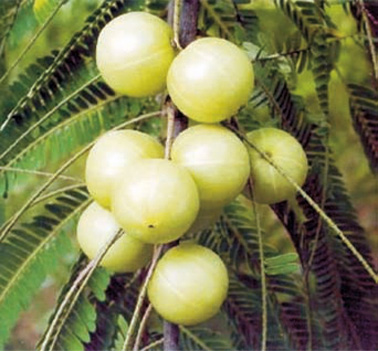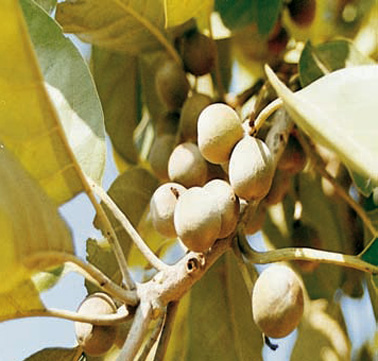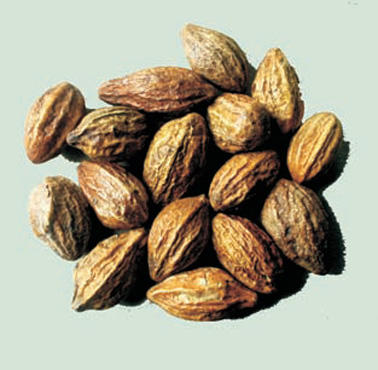|
Triphala is an Ayurvedic powdered formulation made by
combining Emblica officinalis, Terminalia belarica and
Terminalia chebula in equal proportions
1. Amla (Emblica officinalis
Gaertn):
Consists of pericarp of dried mature fruits
of Emblica officinalis Gaertn.Syn. Phyllanthus emblica Linn.
(Fam. Euphorbiaceae)
Botanical description:
Tree; leaves alternate, bifarious, pinnate, flower
-'bearing; leaflets numerous, alternate, linear-obtuse,
entire; petioles striated, round; calyx 6-parted; flowers in
the male very numerous in the axils of the lower leaflets,
and round the common petiole below the leaflets; in the
female few, solitary, sessile, mixed with some males in the
most exterior floriferous axils; stigmas 3; drupe globular,
fleshy, smooth, 6-striated; nut obovate-triangular,
3-celled; seeds 2 in each cell; flowers small, greenish
yellow.
Parts used:
Fruits
Major chemical constituent:
Ascorbic acid and tannins
2. Bibhitaki (Terminalia
belerica):
Consists of pericarp of dried ripe fruits of
Terminalia belerica Roxb. (Fam. Combretaceae), a large
deciduous tree, 10-12 m or more high.
Botanical description:
Bibhitaki is a large deciduous tree found throughout India,
in areas up to an altitude of 1,000 meters. The tree takes a
height of 30 meters, while the bark is brownish grey in
color. The alternate, broadly elliptic leaves are clustered
towards the end of the branches. They are 10 to 12 cm in
length and 7 to 14 cm in breadth. The simple, solitary
flowers are in auxiliary spikes, with offensive odor. They
blossom in the month of May. The fruits are ovoid grey
drupes and the kernels are sweet, but narcotic.
Parts used:
Fruits
Major chemical constituent:
Gallic acid, tannic acid and glycosides
3. Haritaki (Terminalia chebula
Retz):
Consists of the pericarp of mature fruits of
Terminalia chebula Retz. (Fam. Combretaceae), a moderate
sized or large tree found throughout India,
Botanical description:
A tropical shade tree, usually 15–20 m high, but can be up
to 30 m in height, and up to 1.3 m in girth; bark rough,
scaly; shoots and young leaves usually rusty villous. Leaves
simple, opposite, coriaceous, broadly ovate to
ovate-elliptic, 7–15 cm in width by 8–25 cm in length,
glabrescent; veins obscure above, slightly raised and
usually brownish pubescent beneath; apex acute or abruptly
acuminate; base cuneate, slightly cordate or rounded;
petiole 1–3 cm long, glabrous or sparsely pubescent with a
pair of nodular glands near leaf base. Inflorescences
axillary or terminal panicles, usually with 3–6 spikes (each
3–6 cm long); rachis pubescent. Fruit a drupe, glabrous,
subglobose to ellipsoid, 2.5–5.0 cm by 1.5–2.5 cm, usually
smooth or frequently 5-angulate, ridged, wrinkled, turning
blackish when dry. Seed: one, rough, ellipsoid, 1.0–2.0 cm
by 0.2–0.7 cm, and without ridges
Parts used:
Fruits
Major chemical constituent:
Tannins, anthraquinones & polyphenolic compounds
Therapeutic uses
of Triphala:
• Anti-inflammatory (Shothahar)
• Decongestant (Sravahar)
• Soothing (Ksobhahar)
• Wound healing property (Vranashodhaka & ropaka) |
|

Amla

Bibhitaki

Haritaki
|
|
|



